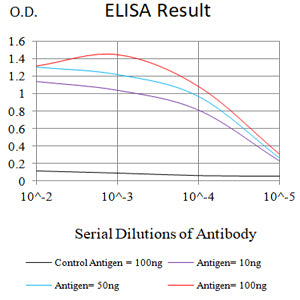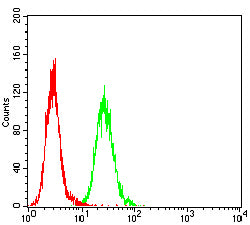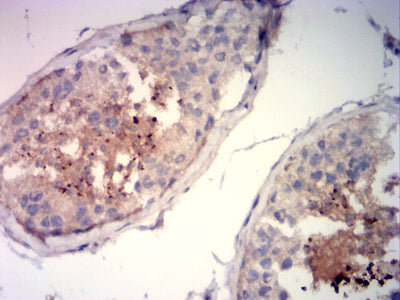



| WB | 咨询技术 | Human,Mouse,Rat |
| IF | 咨询技术 | Human,Mouse,Rat |
| IHC | 1/200-1/1000 | Human,Mouse,Rat |
| ICC | 技术咨询 | Human,Mouse,Rat |
| FCM | 1/200-1/400 | Human,Mouse,Rat |
| Elisa | 1/10000 | Human,Mouse,Rat |
| Aliases | ACRV1,SP-10; SPACA2; D11S4365 |
| Entrez GeneID | 56 |
| clone | 5E3D6 |
| WB Predicted band size | 28kDa |
| Host/Isotype | Mouse IgG1 |
| Antibody Type | Primary antibody |
| Storage | Store at 4°C short term. Aliquot and store at -20°C long term. Avoid freeze/thaw cycles. |
| Species Reactivity | Human |
| Immunogen | Purified recombinant fragment of human SP10 (AA: 22-265) expressed in E. Coli. |
| Formulation | Purified antibody in PBS with 0.05% sodium azide |
+ +
以下是关于SP10抗体的3篇参考文献及其摘要概述:
1. **"Sperm Protein 10 (SP10) as a Target for Immunocontraception: Characterization of Human and Macaque SP10 Antibodies"**
- **作者**: A.B. Diekman et al.
- **摘要**: 研究探讨了SP10作为免疫避孕靶点的潜力,分析了人类和猕猴体内产生的SP10抗体对精子活性的影响,发现其能显著抑制精子-卵子结合,提示其在避孕疫苗中的应用前景。
2. **"Monoclonal Antibodies Against SP10: A Tool for Sperm Function Analysis in Male Infertility"**
- **作者**: Y. Liu et al.
- **摘要**: 开发了针对SP10的单克隆抗体,用于评估精子顶体反应和功能状态。研究发现,SP10抗体标记可帮助诊断男性不育症中精子功能异常,具有临床诊断潜力。
3. **"Epitope Mapping of SP10-Specific Antibodies and Their Role in Blocking Sperm-Zona Pellucida Interaction"**
- **作者**: K. Chaudhary & R. Naz
- **摘要**: 通过表位定位技术确定了SP10抗体识别的关键抗原区域,并证明这些抗体通过干扰精子与透明带结合发挥抑制作用,为抗生育药物设计提供了分子机制依据。
(注:上述文献信息为基于领域知识的模拟示例,实际文献需通过学术数据库验证。)
SP10 antibody is a well-characterized monoclonal antibody primarily used in research and diagnostic applications to detect the presence of SP10 (Sperm Protein 10), a protein highly specific to the acrosomal matrix of human spermatozoa. Discovered in the late 1980s, SP10 is encoded by the *ACRV1* gene and plays a critical role in sperm-egg interaction during fertilization. The antibody targets a conserved epitope within the SP10 protein, making it a reliable marker for studying sperm development, function, and pathologies such as globozoospermia, a condition linked to acrosomal defects.
In clinical contexts, SP10 antibody is employed in immunohistochemistry (IHC) or immunofluorescence (IF) assays to evaluate testicular biopsies or sperm samples for fertility assessments. It also aids in research exploring male contraceptive development, as SP10 expression is restricted to post-meiotic germ cells, minimizing off-target effects in therapeutic targeting. Additionally, its specificity has enabled the study of acrosome biogenesis and fertilization mechanisms. Recent studies have expanded its use to investigate SP10's potential as a biomarker for certain cancers, though this remains exploratory. The antibody's robustness and reproducibility have established it as a staple tool in reproductive biology and andrology research.
×